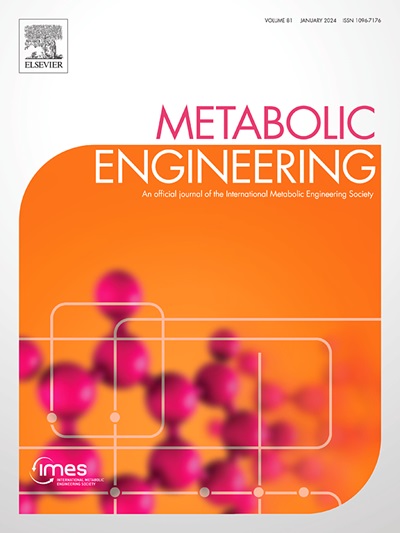在不确定条件下通过酶约束动态代谢通量分析实现细胞培养的多尺度混合建模方法。
IF 6.8
1区 生物学
Q1 BIOTECHNOLOGY & APPLIED MICROBIOLOGY
引用次数: 0
摘要
哺乳动物细胞培养物为制药业做出了重大贡献。每年获得美国食品及药物管理局批准的许多生物制药都是由它们生产的。在设计质量原则的推动下,人们经常尝试各种建模方法来深入了解这些生物过程。然而,这些系统具有高度复杂性和不确定性,涉及不同尺度的时间和空间动态,因此以全面和完全机械的方式建模具有挑战性。本研究开发了一个机器学习支持的细胞培养多尺度建模框架,将宏观生物过程动力学与微观代谢通量分布联系起来。作为一个相关的生物制药案例研究,我们考虑了中国仓鼠卵巢(CHO)细胞批量生产曲妥珠单抗的情况。通过整合宏观动力学和机器学习方法,我们构建了一个宏观混合模型。基于混合模型的动态预测,采用酶约束动态代谢通量分析(ecDMFA)计算通量分布。多尺度模型的不确定性估计是通过引导法进行的。从实验数据来看,我们的混合模型可以将宏观尺度动态的建模误差降低到 8.0%,比纯力学模型降低了 70%。此外,预测的动态通量分布与文献观测结果一致,突出了整个过程中重要的新陈代谢变化。模型的不确定性保持在较低水平,证明了预测的可信度。总之,我们的综合建模框架有望促进生物制药行业数字孪生的发展。本文章由计算机程序翻译,如有差异,请以英文原文为准。
A multiscale hybrid modelling methodology for cell cultures enabled by enzyme-constrained dynamic metabolic flux analysis under uncertainty
Mammalian cell cultures make a significant contribution to the pharmaceutical industry. They produce many of the biopharmaceuticals obtaining FDA-approval each year. Motivated by quality-by-design principles, various modelling methodologies are frequently trialled to gain insight into these bioprocesses. However, these systems are highly complex and uncertain, involving dynamics at different scales, both in time and space, making them challenging to model in a comprehensive and fully mechanistic manner. This study develops a machine-learning-supported multiscale modelling framework of cell cultures, linking the macroscale bioprocess dynamics to the microscale metabolic flux distribution. As a relevant biopharmaceutical case study, we consider the production of Trastuzumab by Chinese Hamster Ovary (CHO) cells in batch. A macroscale hybrid model is constructed by integrating macro-kinetic and machine-learning approaches. Enzyme-constrained Dynamic Metabolic Flux Analysis (ecDMFA) is adopted to calculate flux distributions based on the dynamic predictions of the hybrid model. Uncertainty estimation of the multiscale model is conducted through bootstrapping. Judging from experimental data, our hybrid model can reduce the modelling error of the macroscale dynamics to 8.0%; a 70% reduction from the purely mechanistic model. In addition, the predicted dynamic flux distribution aligns with observations seen in literature, highlighting important metabolic changes throughout the process. Model uncertainty is maintained at a low level, demonstrating the trustworthiness of the predictions. Overall, our comprehensive modelling framework has the potential to facilitate the development of digital twins in the biopharmaceutical industry.
求助全文
通过发布文献求助,成功后即可免费获取论文全文。
去求助
来源期刊

Metabolic engineering
工程技术-生物工程与应用微生物
CiteScore
15.60
自引率
6.00%
发文量
140
审稿时长
44 days
期刊介绍:
Metabolic Engineering (MBE) is a journal that focuses on publishing original research papers on the directed modulation of metabolic pathways for metabolite overproduction or the enhancement of cellular properties. It welcomes papers that describe the engineering of native pathways and the synthesis of heterologous pathways to convert microorganisms into microbial cell factories. The journal covers experimental, computational, and modeling approaches for understanding metabolic pathways and manipulating them through genetic, media, or environmental means. Effective exploration of metabolic pathways necessitates the use of molecular biology and biochemistry methods, as well as engineering techniques for modeling and data analysis. MBE serves as a platform for interdisciplinary research in fields such as biochemistry, molecular biology, applied microbiology, cellular physiology, cellular nutrition in health and disease, and biochemical engineering. The journal publishes various types of papers, including original research papers and review papers. It is indexed and abstracted in databases such as Scopus, Embase, EMBiology, Current Contents - Life Sciences and Clinical Medicine, Science Citation Index, PubMed/Medline, CAS and Biotechnology Citation Index.
 求助内容:
求助内容: 应助结果提醒方式:
应助结果提醒方式:


